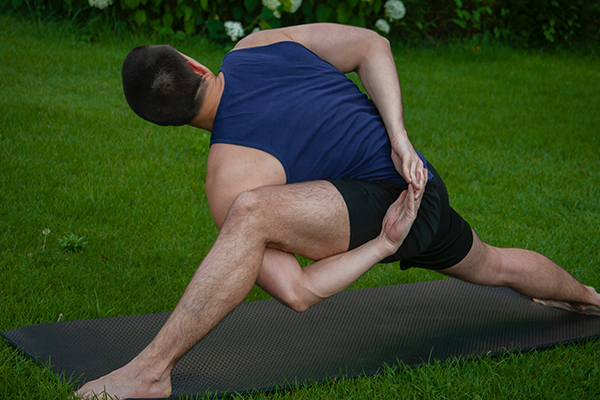Stretching is part of a well-rounded fitness program. It’s believed to assist you to keep foremost motion in your joints, decrease harm risk, and even reduce stress levels. In addition to these benefits, you may additionally be curious whether or not stretching burns calories, tones your body, or aids with weight loss.
What Is Stretching
Stretching involves moving a joint through its full range of motion.
Some stretches hold the end range of a move for longer, while others hold the end range only for a moment. In addition, some forms of stretching involve contracting your muscles during the movement, while others call for your muscles to remain unresistant.
Anyhow of the type, stretching can increase your inflexibility. In turn, this can help you:
- Achieve or maintain full movement
- Ameliorate certain injury symptoms
- Reverse the effects of sustained positions like sitting
Types Of Stretching
Active And Passive Static Stretching
Stationary stretching is the most well-known type. It involves moving your joints to the end range of motion – which may come with slight discomfort – and holding the disguise for a specific period.
Stationary stretches are generally performed in the morning of an exercise routine as a warm-up and at the end for a cool down.
Active stretching involves constricting the antagonist( opposing) muscles to hold a maximum stretch position. The antagonist’s muscle is the one that’s stretching during a movement.
Dynamic Stretching
Dynamic stretching involves the gradual controlled movement of a common toward the limits of its range of motion.
These movements tend to be analogous to exercise movement patterns. For that reason, they tend to increase the core temperature which, theoretically, can prepare a joint for exercise movement.
Proprioceptive Neuromuscular Facilitation (PNF) Stretching
PNF stretching involves passively stretching a joint to its end range and performing an isometric compression hold at that range. This is when a muscle is flexed but isn’t expanding or contracting. As a result, the joint is laboriously or passively moved further into the range of motion.

Ballistic Stretching
Ballistic stretching involves snappily and semi-forcefully moving a joint to its end range of motion, eliciting a minimal length for only a short period. You can use bouncing to achieve this.
Still, keep in mind that if done inaptly, ballistic stretching can come with a risk of injuring soft tissue like tendons or ligaments. Be sure to try this type of stretch only after consulting with healthcare or exercise professional.
Can You Lose Weight By Stretching
So in short: yes! Stretching can really help with weight loss in your life. Stretching helps increase blood inflow to the muscles, which in turn increases oxygen and nutrients to them, and this helps warm up the muscles before you begin exercising. It means that you’ll perform better, briskly, and stronger during your workouts.
Also, as with any movement that you do, be it a hard exercise or walking, stretching also is an act of movement, which means that stretching burns calories. However, it’ll help you to lose weight If you burn further calories than you consume.
The stylish thing about stretching is that it can fluently be incorporated into any exercise program and you don’t have to do it the way you might have to with machines! Now, let’s see how you can make stretching a huge( and veritably comforting!) part of your weight loss routine.
Why Does Stretching Help With Weight Loss
There are several reasons why stretching is an excellent way to shed some pounds, but we’re going to list only the top 4 ones
Calories: As we’ve compactly mentioned, you’re going to burn calories with every second you hold a stretch.
Metabolism: The acts we’re going to give away greatly help with bringing your entire digestive system into a state of balance.
Stress: There’s a comforting quality to stretches and a calm body is a body that reacts better to every kind of physical exertion.
Muscles: Eventually, stretching builds muscles as well, because different stretches target different muscle groups, which, when combined rightly, does wonders!
How long should I hold a stretch
As you can see, occasionally we give an average time a person should hold a stretch. still, the quantum of time you should spend holding each stretch is wildly individual.
The rule of thumb is that you should try holding a stretch until you start feeling “the burn”, that is, until you feel your muscles replying to it, and also a couple of seconds longer. The important thing isn’t to overdo it, as even stretching too hard can cause injuries.
What Stretches Should I Do To Lose Weight
We’re going to list all the 10 most important types of stretches you should do on a regular basis if you’re looking to lose a bit, or a lot, of weight
The cobra stretch: Lie down on your stomach, and lift your upper body towards the sky, helping yourself with your arms.
Seated twists: Sit down, back straight, bend one leg at the knee and place it over the other one, which you should keep on the bottom and straight. also, turn your upper body on the contrary direction.
The warrior: Perform a slight forward jab while keeping your arms straight above you, your hands clasped together and your reverse straight.
The bridge: Lie on your reverse and raise your pelvis as much overhead as you can. Hold for half a second to an alternate.
Side lunges: Stand up with your reverse straight and spread your legs sufficiently piecemeal, also transfer all your weight to your one knee while bending it.
Inner thigh stretches: Sit on the bottom, keep your reverse straight, and bring together the soles of your bases while dropping your knees sluggishly to the sides.
Knee squeezes: Lie on your reverse, fold your legs at the knees, and bring them towards your upper body while squeezing them with your arms.
